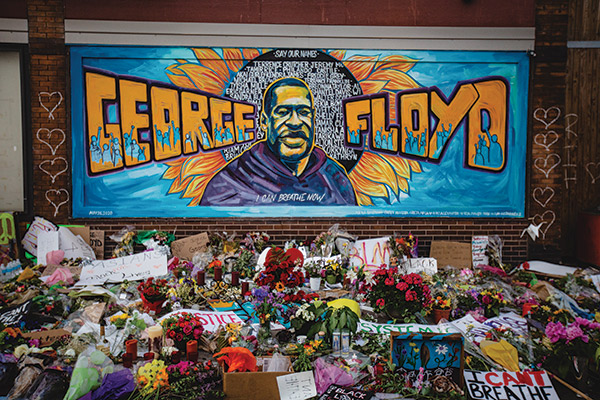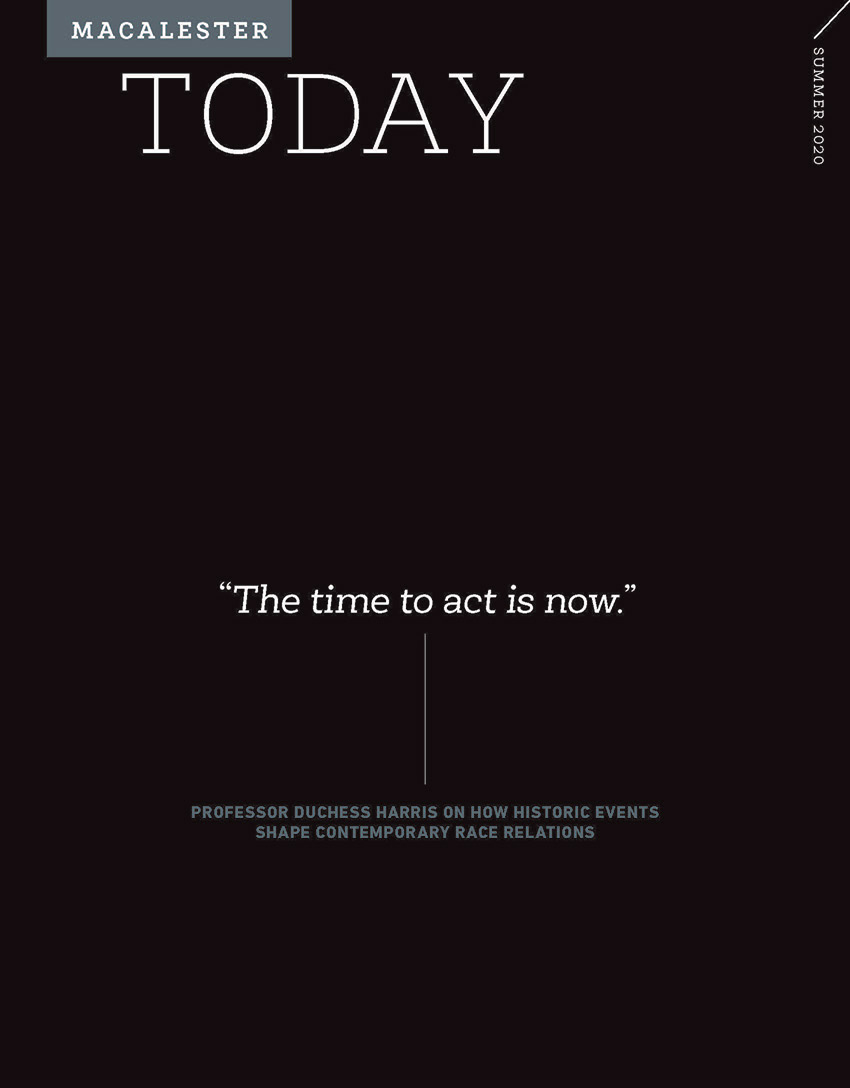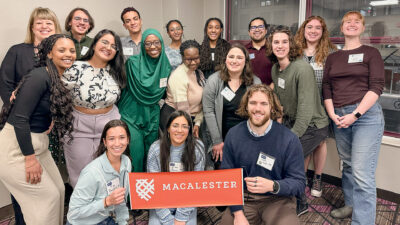
How did we get here? That’s the question that American studies and political science professor Duchess Harris has been fielding from media outlets ever since George Floyd was murdered in Minneapolis on May 25. An expert on civil rights law, Black feminism, and African American political movements, the professor can’t answer without drawing on history: “One of my favorite political theorists, James Baldwin, says in the Evidence of Things Not Seen, “History, I contend, is the present—we, with every breath we take, every move we make, are History—and what goes around, comes around.”
But the connections and lessons we need to understand this summer’s demonstrations and uprisings, Harris says, are often left out of the high school curriculum. Harris faced a troubling lightbulb moment in 2014, when she returned to the classroom to teach “Introduction to African American Studies” and “Race and the Law” a month after Michael Brown was shot and killed in Ferguson, Missouri. “I found out that none of my students had had any experience talking about contemporary race relations in high school,” she says. “Students sometimes have a unit on slavery, but they don’t get the skill set to talk about race relations—and it’s an important skill set to have.”
She got to work to start correcting that problem. In the past five years, in addition to her coursework on campus, Harris has published 115 books on race and gender geared toward fourth through twelfth graders.
In a June presentation for alumni, she reflected on the events that led to the summer of 2020.
Introduction by Rebecca DeJarlais Ortiz ’06
During the June alumni webinar, moderator Justin Brandon ’00—incoming Alumni Board president, high school principal, and one of Duchess Harris’s former students—led a Q&A with Harris, drawing from more than 100 questions submitted by alumni on race and policing’s history and future. Their conversation is excerpted and adapted for print.
Why do you think race issues seem to be news to white America?
I discussed that in my home last night for more than an hour. I think it’s because we can return to the 1968 Kerner Commission, which said that we are living in two societies. For some white Americans, George Floyd was shocking. For many Black Americans, it wasn’t. I think what some white Americans don’t realize is that Black Americans walk through the world and think about Trayvon Martin, Michael Brown, Jamar Clark, Freddie Gray. That’s part of what it means to be Black in America. Our culture has a disconnect around who could have lived their whole life so far and not engaged the notion that a lot of people don’t think Black lives matter.
How can we respond to people who don’t agree that you can respect and honor our good police officers and also seek change?
That’s why I’m celebrating St. Paul leadership: Mayor Melvin Carter III recognizes that there’s good policing, because he was raised by good policing. His mom is a county commissioner, his father is a retired police officer, and they are African American. I think that he also knows there needs to be police reform. In his dad’s beautiful autobiography, his dad says that he sometimes felt more intimidated in uniform than plainclothes, and so much of that had to do with the fact that he was Black.
Has the conversation on police abolition versus reform shifted?
I really think it has. As recently as six months ago, there wasn’t much of an audience for abolition. I think George Floyd being killed has changed the conversation around the world. In June, the Minneapolis City Council voted to advance a proposal that would replace the police department with a Department of Community Safety and Violence Prevention. It’s one step of many, but the fact that it was unanimous says a lot about how this one event has changed so much in our culture. We’re in a moment now where people are thinking about concepts that no one was thinking about a year ago.
Have you seen places where a community policing model works?
The entire country is making a shift, but I can’t point to one place and say, “They have it figured out.” In Los Angeles, Mayor Eric Garcetti is giving less funding to policing and giving some of that money to other spaces. I think the fact that a city as large as Los Angeles is even considering reform means we’ve come so far. I came of age in the era of Rodney King—I remember that like it was yesterday. Absolutely no police reform would have been thought of in the early ’90s.
One of my students asked how we can address the twin pandemics: COVID-19 and racism. How is dealing with these twin pandemics different for communities of color?
Atlanta pastor Raphael Warnock recently said Black America is suffering from COVID-1619 (in reference to the year when enslaved Africans were first brought to North America). He meant that everything that makes COVID what it is for white America is compounded for Black Americans—because Black Americans were already fragile. Black Americans already had issues with access: sitting in food deserts, places that didn’t have the best housing, that didn’t have community policing or great healthcare. And if you have any of those things, you might not have a job.
That’s what COVID-1619 is. You already had all the problems. Now you’re in a pandemic.
How do we encourage white friends to have conversations among themselves about their complicity in systemic inequity—and not be there as the spokesperson for all Black people?
That’s a challenge. Given what I do, I get lots of emails right now from white Americans who want me to fix something for them. There are many things I’m not capable of fixing. The challenge, really, is white Americans having the courage to say, “We’re going to try this on our own.” That takes a lot of courage, because our nation isn’t structured so they would have learned anything, especially in K–12. That’s why I like writing these books.
What do you think is missing in the approach to teaching a full American history?
When I was in high school in 1983, the methodology was colorblind. Even though we’ve moved from colorblind to diversity, there still isn’t a lot of conversation about what justice looks like, nor a lot of historical context. You have people who were shocked about George Floyd, because they didn’t learn about Emmett Till in high school. There are only six books in the country written about Emmett Till for fourth- through twelfth-graders.
How do you have these conversations with kids?
Regardless of a child’s age, a good way to open up is to ask: What do you see? What do you know? I had my first experience as a parent with this with George Floyd, because when Philando Castile happened, my kids weren’t old enough for technology. When George Floyd happened, I paused and said, “Okay, how am I going to approach this?”
I’ll admit, I was a day late and a dollar short. When I approached my 13-year-old, he said, “I saw the video.” I couldn’t believe that he watched the video, and I told him how concerned I was, and he said, “Mom, 20 million people have seen it on Instagram—why wouldn’t I watch it?” That’s part of it now: you can run but you can’t hide.
We received a question asking your perspective on people of color trying to hurt the Black Lives Matter movement.
In my “Black Public Intellectuals” class, we talk about the range of political thought within the African American community—it’s not a monolith. It’s always had conservatives. There’s room for variety in Blackness in the way that there should be room for variety in anything. There should be free thought.
There’s always this trap: shouldn’t all Black people be on one team?
We need to think about generational differences. I don’t think there’s any reason in the world why my kids should see the world the same way I do. I don’t see the world the way my parents did. My parents were born in the 1930s and lived in segregation until they were 35. That’s very different from how I grew up, which is also very different from how my kids are growing up. Black people can’t be all alike.
Duchess Harris’s next book, Justice for George Floyd, is due out in January 2021 from the ABDO publishing company. “It’s written for fourth- through eighth- graders, but I believe many adults will benefit from it as well,” she says.

1857
Dred Scott
After Dred Scott was enslaved in Missouri, he comes to live at Fort Snelling in Minnesota as a free person. When he goes back to Missouri, he wants to continue to live as a free person. His case goes all the way to the Supreme Court, and in 1857, he loses. He’s denied citizenship. The Supreme Court rules that “a Black man has no rights that a white man is bound to respect.” Dred Scott is in an area of Missouri that’s in very close proximity to where Michael Brown ends up lying on the ground more than 150 years later. Remember James Baldwin: “What goes around comes around.”
1865-1877
Reconstruction
I frame each time period in terms of hope and despair. During Reconstruction, the hope is clearly Emancipation. The despair, however, is that there’s so much resistance. Some people don’t realize that Reconstruction is the time when we had the Klan. It leads to 58 years of legal segregation after 246 years of slavery. Sometimes students learn that once slavery is over, people are free. That’s not necessarily true.
1960s
Civil Rights Movement: Public Opinion
There’s lots of backlash in the 1960s. In 1963, Gallup polls indicate that 60 percent of Americans are opposed to the March on Washington—that’s surprising, because now we glorify this event. When young college students sat at the Woolworth’s lunch counter to desegregate it, 57 percent of the nation thought it was counterproductive. We also tend to put Dr. Martin Luther King Jr. on a pedestal, but in the 1960s, half of white America believed that he was harming the movement. I ask my students to think about what an event is like when it’s actually happening and then how the story is told, when we revisit it later. All of this is important when we talk about the contemporary movement and what has happened in the last eight years with Black Lives Matter.
1960s & 1970s
Formative Public Policy
There’s federal legislation—including the Civil Rights Act of the 1960s—focused on voting, fair housing, and eliminating discrimination. Within the community, Black feminism, Black power, and the Black Arts movement begin. But we also have to talk about how the government has been complicit in some of the social issues that we have. In the 1960s and 1970s, banks and lawmakers aided and abetted white flight, which continues housing discrimination and practices like redlining. All of this urban decay ends up with crime and poverty that you don’t have in the suburbs—but African Americans don’t have access to the suburbs. One of the things I argue in my Race and Policing book is that this is really about more than policing. There are other public policy issues at hand: this is about housing; this is about jobs.
Beginning: 1970s
War on Drugs
One of the War on Drugs’s terrible outcomes is the discrepancy in sentencing between people who were caught with crack cocaine and powder cocaine. This has a devastating impact on Black communities. In the early 1990s, Black people were five times more likely to be arrested for drug offenses than a white person committing the same crime. Black people made up 40 percent of all drug-related arrests despite being 12 percent of the population.
1996
Welfare to Work Bill
There was tremendous resistance in the Reagan and both Bush administrations, but the Clinton administration was also a lot more moderate on public policy issues related to race than sometimes people think. For instance, in photographs of
President Clinton signing the Welfare to Work bill, he chooses to surround himself with African American women. The image makes Americans think that women who look like this would be the beneficiaries of welfare. That’s not accurate.
2009
Henry Louis Gates Arrest
For me, one of the most challenging and intriguing questions is why a social movement like Black Lives Matter comes about after we get our first Black president. This question alone has inspired me to teach a class on the Obama presidency. One argument that I make is that President Obama avoided domestic U.S. race relations for his entire first term. It isn’t until his second term that he runs into the problem, when Harvard University African American Studies scholar Henry Louis Gates is actually arrested inside his own house in Cambridge. Gates comes back from a business trip and has a hard time finding his keys. His neighbors call police to report a Black man on the porch, but he finds his keys and goes inside. The police come, and they still arrest him. Gates is outraged. His counsel gets in touch with the president, who has the idea to have a beer summit. President Obama gathers with Vice President Joe Biden, Gates, and the arresting officer, to try to smooth things out. This was not well received by either Black or white people.
2012
Trayvon Martin
After George Zimmerman shot Trayvon Martin, President Obama returns to the same Rose Garden space where he had the beer summit, and he says, “If I had a son, he’d look like Trayvon. I think all of us have to do some soul searching to figure out how does something like this happen. And that means we examine the laws and the context for what happened, as well as the specifics of the incident.”
But this is the strongest hand that he has had in terms of race relations up until this point. The young generation is not particularly inspired by this. And in this moment, you see a racial divide: the Washington Post tells us that 86 percent of African Americans are extremely upset that Zimmerman goes free, and then only 30 percent of white Americans are as upset as Black people are.
2013
#BLM Begins
When George Zimmerman is acquitted for killing Trayvon Martin, three women—Patrisse Cullors, Alicia Garza, and Opal Tometi—all get together and start tweeting that Black lives matter. That’s when it becomes a hashtag. There were five million #BLM tweets in one day, which was unusual in 2013.
2014
Eric Garner
There continue to be murders of Black men by white police officers, but the one that gets the most media attention is when Eric Garner says in New York City that he can’t breathe. Once again, we’re in a situation where we have videotape, the world knows what’s going on, we get a trial, and the police officer is found not guilty. This results in uprisings throughout the nation.
Michael Brown
When Michael Brown is killed in Ferguson, Black Lives Matter moves from a hashtag to what some would call a contemporary civil rights movement on the ground. People get in their cars, get on planes and fly to Missouri, and have peaceful protests, marches, and demonstrations.
2015
Freddie Gray
Six months later, Freddie Gray is killed in Baltimore. It shouldn’t surprise anyone that Black Lives Matter had a lot of resistance—it was not a popular movement. In fact, 55 percent of Americans during this time period think Black Lives Matter is actually a distraction.
Jamar Clark
Jamar Clark is shot in Minneapolis. There are numerous protests throughout the Twin Cities, and this makes national news. By early 2016, though, still only 25 percent of white America agree that Black Lives Matter even has a purpose.
Summer 2016
Fourth of July Weekend
The tone and tenor of public opinion in Minnesota begin to shift after Philando Castile is shot in the heart by a police officer, not that far from Macalester. Then-governor Mark Dayton says that he doubted that Castile would have been shot if he’d been white. This is considered very controversial and the governor is accused of race-baiting.
However, it had been a very challenging week. People don’t want their holidays to be complete chaos, but that’s what happened four years ago. On July 5, Alton Sterling was killed by police officers in Baton Rouge. The next day Philando Castile is killed. Micah Johnson, who’s African American, shoots police officers in Dallas and then police kill him with a bomb. All of this happens in four days.
2016
Colin Kaepernick Kneels
In September, football player Colin Kaepernick takes a knee during the pre-game national anthem and inspires a wave of other athletes. He starts supporting Black Lives Matter. He is no longer playing football.
2020
Just over two months after Breonna Taylor is shot and killed by police in Louisville, Kentucky, George Floyd is murdered by police in Minneapolis over Memorial Day weekend. For years I’ve watched people resist talking about race in policing and Black Lives Matter—I do this for a living—and I’ve been shocked by the radical change in public sentiment this summer. There’s no better example than when Republican senator Mitt Romney takes to the streets in June, joins a rally, and tweets Black Lives Matter. This would have been unthinkable years ago. There’s been a change in the tide.
What historical parallels are you thinking about this year? Tell us: [email protected]
Updated Aug. 24, 2020
August 18 2020
Back to top





